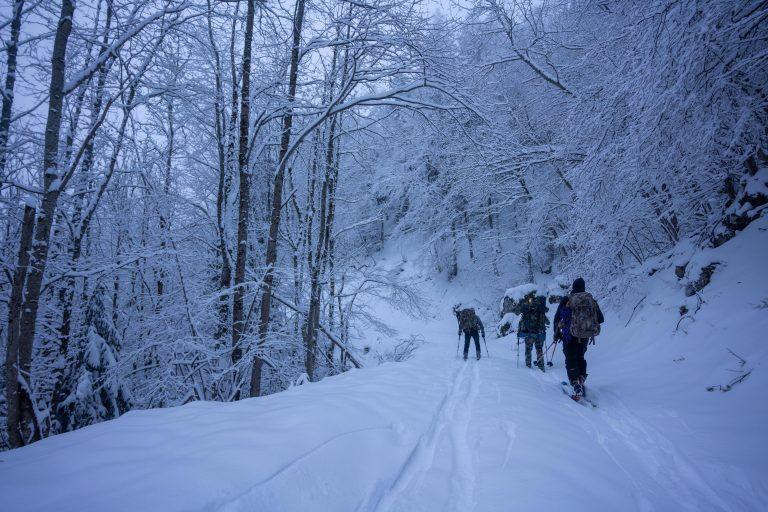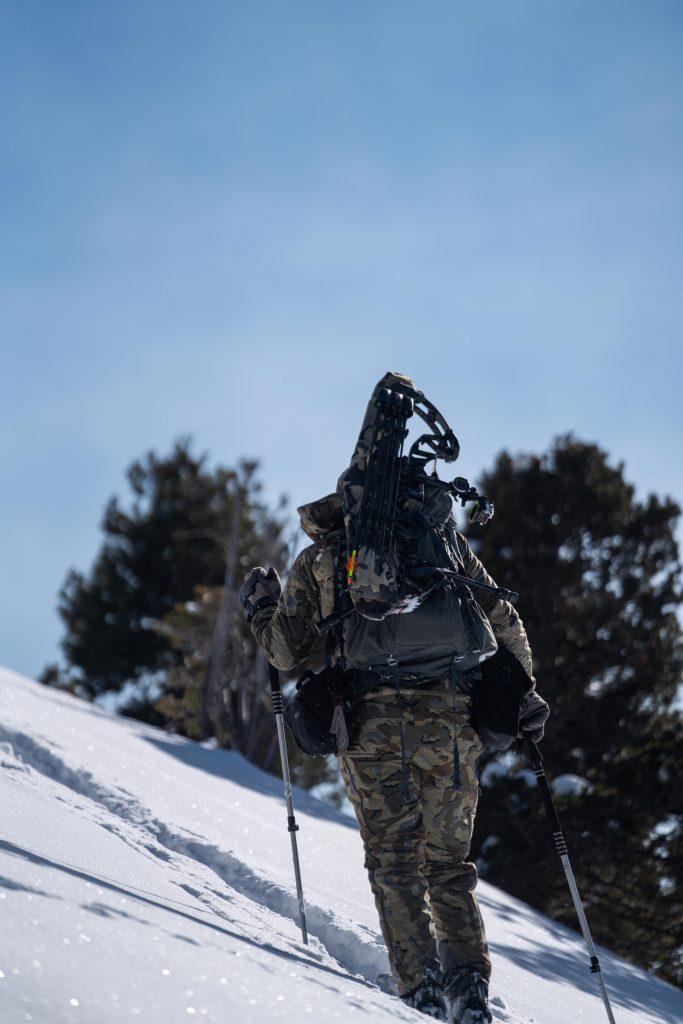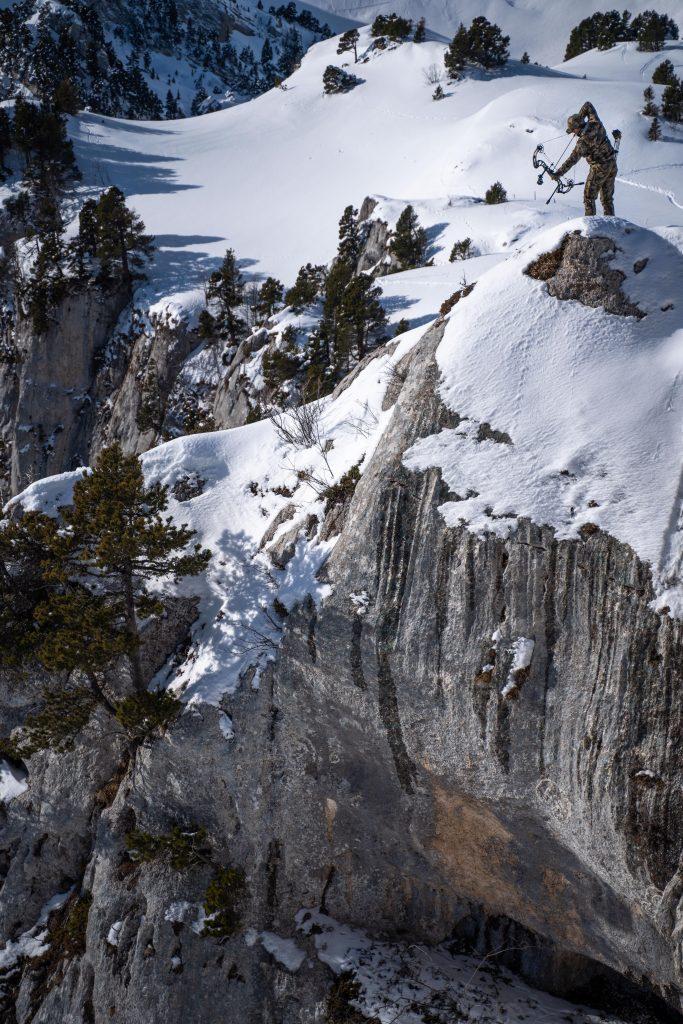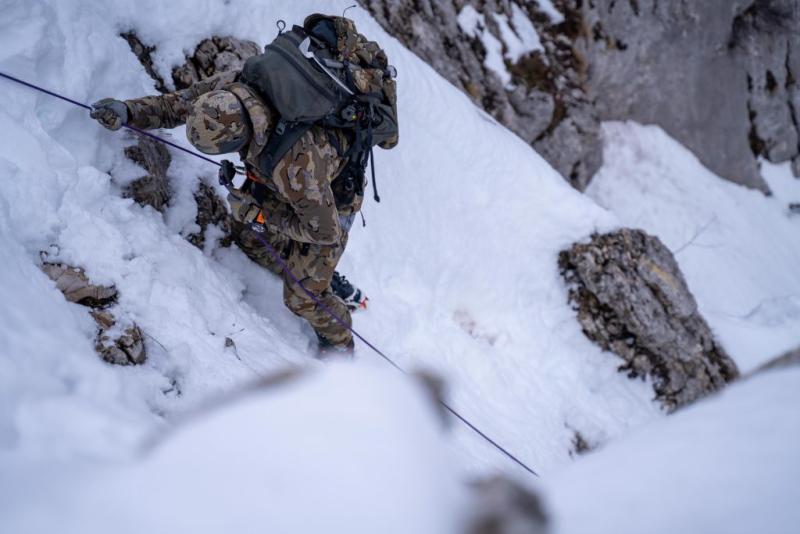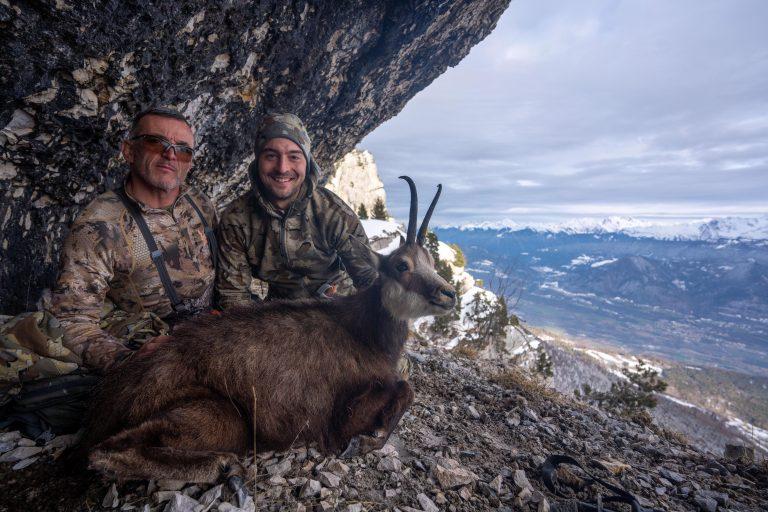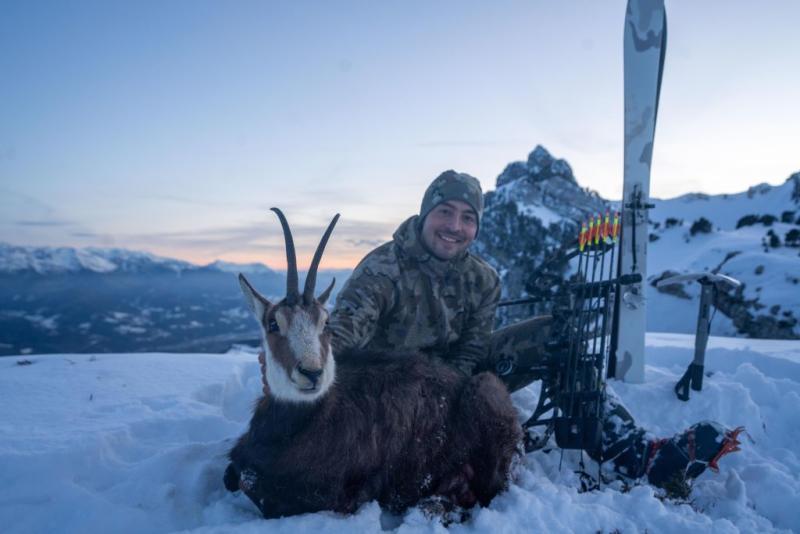Beyond your limits
An alpine winter backpack hunt for chamois in the Chartreuse Mountains.
Story: Pedro De Ampuero
Photos: Raul Del Valle and Pedro De Ampuero
After a bunch of hunts and trips cancelled during the last year, I couldn’t believe I was at the end of a road securing my bow to the outside of a fully loaded pack getting ready to start climbing up again. Is it typically then, when you feel the weight of your pack, you see the terrain in front of you, when you realize what you just got yourself into.
It is mid February and with just a few weeks left of season we couldn’t delay our adventure any further. Covid and the amount of snow had already ruined our plans earlier this year, but this time no matter the conditions we agreed with Phillipe Simon, our guide, that we will go and give it a try.
This time of the year its probably the worst time to hunt, there is too much snow which makes it harder not only for covering ground and stalking, but also for finding chamois, as they limit their activity to a minimum.
On the other side, it is the best time to experience a true adventure, as conditions will push you to your limits, something that was way more important for us than harvesting a chamois. That desire of adventure quickly came back to me, as I was getting on top of some skies for the first time in my life. There was too much snow to do the hunt on foot, and skies was the only option. I was commited to do whatever it took, and I told the guides not to worry, that I would manage.
The 5 hour climb was exhausting, but I quickly learn how to move uphill and how to turn. We had to use ski crampons on a big portion as the slope was so steep that the seal skin will not hold our weight. We covered also a couple segments with climbing crampons as the terrain was just too dangerous. Most of the times reaching the top of the mountain is relieving, but this time it was not for me. After such a physical effort with a pack loaded to spend a week on top of the mountain, we had to drop now to the next valley where our little hut was located.
In pitch darkness I was removing the skins off my skies, in order to take my first ever lesson on how not to die on your first day skiing. Powder, heavy pack, steep slope and darkness are great ingredients for a disaster, but fear kept me strong and I was able to make it to the hut in one piece. It felt that we were going to have a fun week ahead.
Phillipe owns some land in the Chartreuse Massif, located close to Grenoble in France, just a few kilometers away from the Alps Mountain Range. That separation is why the French consider the Chartreuse Chamois a different subspecies, that despite they look the same as the Alpine Chamois, the physical barrier between the mountains have isolated the chartreuse population for many years.
In his property Phillipe built a hut big enough for four people, with all the luxuries you need in the mountains, which is some light, a roof and a stove, something that makes a huge difference specially on winter hunts. Our plan was to spend a week there with a good friend of mine Raul del Valle, which we were planing both to hunt and film each other.
In chartreuse the tags are very limited, only issuing maybe 40 permits a year. That exclusiveness added to the recognition as a subspecies by the hunting organizations makes this chamois one of the most expensive ones, roughly doubling or tripling the price of an Alpine Chamois. With so many cancelations and restrictions, this last year was probably the best one to get a special deal, as international hunters were very restricted.
We would start every day with the first light jumping on our skies, and covering ground in search of chamois. Animals are smart, and always tend to be where finding food is more energy efficient, where it requires them less energy to feed. With so much snow, the cliffs and very steep places were the only areas where the snow will not hold, and chamois would be there feeding. We would check every day those cliffs from the top, hoping a chamois would be in range and offer us an opportunity. When I mean steep, I mean that steepness that when you peak over you will hold your breath or you would need to crawl to feel safe, and that if you glass for a bit too long you get a bit dizzy.
Chamois are little animals with small hooked horns that are really not impressive, and if you have never hunted them you may not understand why so many people are completely in love with them. In my opinion they represent pure mountain hunting, and that insignificant trophy or that particular beauty is not by accident. God wanted to filter the true lovers of the mountains and the challenge, that search for the experience above any trophy. They live in the most complicated terrain animals can live, and survive some of the toughest winters like nothing. They are the fittest and quickest animal you will find, and you would have to work hard to deserve harvesting one.
I have chased them in all the different mountain ranges of the world, Anatolia (Turkey), Caucasus (Russia), Carpathian (Romania), Balkan (Bulgaria), Picos de Europa (Spain), Pyrenees (Spain), Alps (France), Alps (New Zealand), except the Chartreuse Massif. Although that’s just an excuse, because after knowing Phillipe for many years, I wanted to hunt with him because we understand hunting the same way, and for both of us, chamois means way more than just an animal.
After a couple days peaking over cliffs, and seeing some chamois, I started to realize the huge challenge we had ahead. We were very limited on our stalks, as the terrain and snow conditions made most places too risky to walk, not to mention the recovery of the animals in such a place. That was a problem for later though, as we can’t control what the animals will do, so we just needed to keep peaking over the cliffs and cross our fingers for an opportunity.
It was in one of those spots when we jumped on a bedded chamois a few meters away from us. The chamois jumped over the cliff surprising all of us and we rushed to peak over in case it would give us a second opportunity as it looked like a really old chamois. I quickly got ready and asure my front foot on the snow to make sure I had a solid rest in case I had to take a shot. In angle shots as you need to bend yourself forward, it can be very risky and you need to make sure you are super confident with your feet rest to take a proper shot.
„A few minutes passed by and I started to think that the chamois may have crossed underneath us without us seeing it, but suddenly out of nowhere it appeared across the creek. I measured and the range finder displayed a 50 yard shot compensated to 25 yds. It was so steep that I could barely see more than his back, but considering this was probably the best opportunity I would have, I took a deep breath and drew the bow back. I paid particular attention to the bubble level as there is no room for error and you completely lose idea of where the horizon is in such steep terrain. I relaxed and let the string go.”
The arrow sounded like a hard hit and the chamois run up for a few meters, stopped acting strange and run down the cliff to disappear out of sight. There was some blood , not much, that we could see on the snow, and the arrow was stuck on the ground that was underneath the chamois. I was confident about the shot but at the same time worried because you never want to celebrate too early, specially when one inch to the right or left means to be out of the vital area.
The excitement last very little, as soon as we all realized where the chamois went, and how hard the recovery was going to be. The terrain was so dangerous that my guts started to hurt just thinking about what we got ourselves into. Talking with my good friend Raul as we analyzed the options of going down, made us think about if all that was worth it for an animal, and if we just went a bit too far and we should have thought about it before taking the shot.
It was my responsibility and I was committed to do whatever it took, since we had the equipment to attempt the recovery safely, but first we had to try to understand where the chamois went. That’s when I had my only good idea on this trip, lets fly the drone up, and see if we could see the chamois! If we couldn’t find it, at least we could check the terrain to plan our recovery. I flew the drone up and over the cliff trying to follow the tracks on the snow where we last saw the chamois. It is very hard to spot a 50 lbs bedded animal with a drone but the terrain was so gnarly that the animals could actually only have crossed the wall in one place. In that place there was a little cave in the middle of the wall that looked like a great bedding spot. With very little confidence I got close to the dark cave and when I was only a few meters away I saw the chamois laying dead inside. We couldn’t believe it!! We quickly took some photos with the drone from several angles to make sure we took the right route to the cave and to analyze what equipment was needed.
Knowing this terrain we were prepared and had all types of climbing gear on our packs, so we quickly jumped inside our harnesses. The plan was to rappel down the first cliff with a 150ft rope, then transition with the crampons and ice axe along the top of the second cut, to place a second anchor and rappel down to the cave. Getting the crampons and ropes ready makes you realize how stupid was to postpone over the last couple of years the climbing training. I should have been better prepared for this, but luckily we had the equipment and Phillipe who had a lot of climbing experience.
I have to admit I have never been so scared on a hunt in my life. Rappelling down for my first time ever with a 1000ft drop underneath me made my mouth so dry that I could barely talk.
Slowly but precisely we got over the obstacles and made it to the chamois. The feeling was incredible, it was a super old nanny, past her breeding age and a magnificent representation of the species. That being said we were half the way on our mission, as we had to take the whole animal up the same way we came, to take care of all the meat.
Just with the last light of the day, we arrived to the top and we finally could celebrate. Exhausted physically but mostly emotionally we skied down to the hut to toast with some French Champaign and enjoy some fresh chamois backstrap. I have been in many chamois hunts, but this one was the most beautiful one I have ever done, and made us think how lucky we were of being up there enjoying life and friendships. We spent a few more days and Raul was able to harvest also another beautiful chamois, that had to be recovered the day after we left, as 2 ropes of 200ft weren’t enough.
To date I am still not sure what was going through my mind when I said I would manage the sky, the climbing, and the hunting, but luckily all worked out and it pushed me out of my comfort zone only to fall in love with chamois and the mountains even more. Proving that no mater how much experience you have, mountains will always put you on your place.


